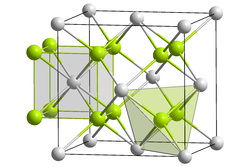Praseodymium (III, IV) oxide
| Crystal structure | ||||||||||||||||
|---|---|---|---|---|---|---|---|---|---|---|---|---|---|---|---|---|

|
||||||||||||||||
| __ Pr 3 + / 4 + __ O 2− | ||||||||||||||||
| General | ||||||||||||||||
| Surname | Praseodymium (III, IV) oxide | |||||||||||||||
| Ratio formula | Pr 6 O 11 | |||||||||||||||
| Brief description |
black odorless solid |
|||||||||||||||
| External identifiers / databases | ||||||||||||||||
|
||||||||||||||||
| properties | ||||||||||||||||
| Molar mass | 1021.44 g mol −1 | |||||||||||||||
| Physical state |
firmly |
|||||||||||||||
| density |
6.5 g cm −3 (20 ° C) |
|||||||||||||||
| Melting point |
2500 ° C |
|||||||||||||||
| boiling point |
4200 ° C |
|||||||||||||||
| solubility |
practically insoluble in water |
|||||||||||||||
| safety instructions | ||||||||||||||||
|
||||||||||||||||
| Toxicological data | ||||||||||||||||
| As far as possible and customary, SI units are used. Unless otherwise noted, the data given apply to standard conditions . | ||||||||||||||||
Praseodymium (III, IV) oxide (Pr 6 O 11 ) is a chemical compound of the chemical elements praseodymium and oxygen from the group of metal oxides .
Occurrence
Praseodymium (III, IV) oxide occurs naturally as an admixture in minerals such as bastnesite , monazite and xenotime .
Extraction and presentation
Praseodymium (III, IV) oxide can be obtained by burning praseodymium with oxygen.
properties
Praseodymium (III, IV) oxide is a black, odorless solid that is practically insoluble in water. The trivalent praseodymium is represented twice, the tetravalent praseodymium is represented four times. Formally it can be understood as Pr 2 O 3 · 4 PrO 2 . It crystallizes in the cubic crystal system in the fluorite structure , with 1/12 of the oxygen sites remaining unoccupied; the lattice parameter is 546.8 pm . It decomposes on contact with water vapor to praseodymium (IV) oxide and praseodymium (III) hydroxide .
It should be noted that there are other intermediate phases between praseodymium (III) oxide and praseodymium (IV) oxide with the general formula 2 Pr 2 O 3 · m PrO 2 (0 <= m <= 8) or Pr n O 2n-2 (4 <= n <= 12).
use
Praseodymium (III, IV) oxide is used for coloring glass and ceramics.
literature
- RL Martin: "Oxides of Praseodymium", Nature (February 4, 1950), 165 , pp. 202-203 ( doi : 10.1038 / 165202b0 ).
- T. Weisemoeller, C. Deiter, F. Bertram, S. Gevers, A. Giussani, P. Zaumseil, T. Schroeder, J. Wollschläger: "Epitaxy of single crystalline PrO 2 films on Si (111)", in: Appl . Phys. Lett. , 2008 , 93 , 032905 ( doi : 10.1063 / 1.2958227 ; PDF ).
- M. Shamshi Hassan, M. Shaheer Akhtar, Kyung-Bo Shim, O-Bong Yang: "Morphological and Electrochemical Properties of Crystalline Praseodymium Oxide Nanorods", in: Nanoscale Research Letters , 2010 , 5 , pp. 735-740 ( doi : 10.1007 / s11671-010-9547-8 ).
- Sergio Ferro: "Physicochemical and Electrical Properties of Praseodymium Oxides", International Journal of Electrochemistry , Volume 2011, Article ID 561204, 7 pages ( doi : 10.4061 / 2011/561204 ).
Individual evidence
- ↑ a b c d e f g h i j Entry for CAS no. 12037-29-5 in the GESTIS substance database of the IFA , accessed on February 2, 2013(JavaScript required) .
- ^ VS Sastri, Jean-Claude G. Bunzli, V. Ramachandra Rao: Modern Aspects of Rare Earths and Their Complexes . Elsevier Science & Technology, 2003, ISBN 978-0-444-51010-5 , pp. 13 ( limited preview in Google Book search).
- ↑ Ginya Adachi, Nobuhito Imanaka, Zhen Chuan Kang: Binary rare earth oxides . Springer Netherlands, 2004, ISBN 978-1-4020-2568-6 , pp. 166 ( limited preview in Google Book search).
- ↑ Christian Klixbüll Jørgensen, Elfriede Riitershaus: "Powder-diagram and Spectroscopic Studies of Mixed Oxides of Lanthanides and Quadrivalent Metals", in: Mat. Fys. Medd. Dan. Vid. Selsk. , 1967 , 35 (15), pp. 1–38, here: p. 15 ( PDF ( page no longer available , search in web archives ) Info: The link was automatically marked as defective. Please check the link according to the instructions and then remove it this notice. ).
- ↑ JD McCullough: "An X-Ray Study of the Rare-earth Oxide Systems: Ce IV -Nd III , Cr IV -Pr III , Ce IV -Pr IV and Pr IV -Nd III ", in: J. Am. Chem. Soc. , 1950 , 72 (3), pp. 1386-1390 ( doi : 10.1021 / ja01159a085 ).
- ↑ E. Daniel Guth, JR Holden, NC Baenziger, LeRoy Eyring: "Praseodymium Oxides. II. X-Ray and Differential Thermal Analyzes", in: J. Am. Chem. Soc. , 1954 , 76 (20), pp. 5239-5242 ( doi : 10.1021 / ja01649a088 ).
- ↑ Becky L. Treu, William Fahrenholtz, Matthew O'Keefe, Eric Morris, Richard Albers: "Effect of Phase on the Electrochemical and Morphological Properties of Praseodymium-Based Coatings", in: ECS Transactions , 2011 , 33 (35), p 53–66 ( doi : 10.1149 / 1.3577753 ; limited preview in Google book search).
- ↑ RA Mashelkar: Solid State Chemistry: Selected Papers of CNR Rao . World Scientific, 1995, ISBN 981-279-589-8 , pp. 339 ( limited preview in Google Book search).
